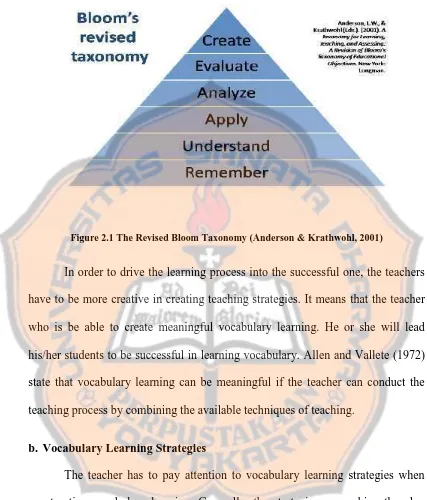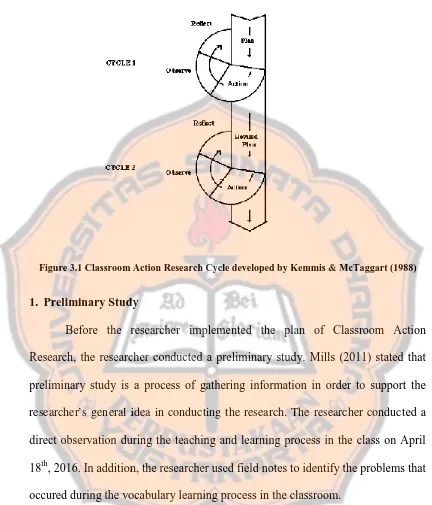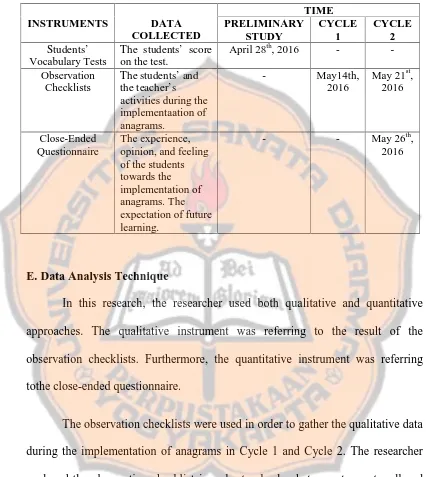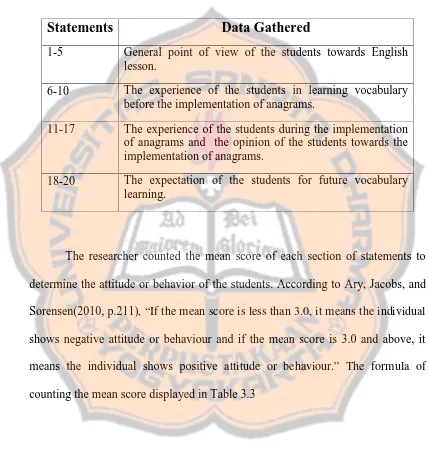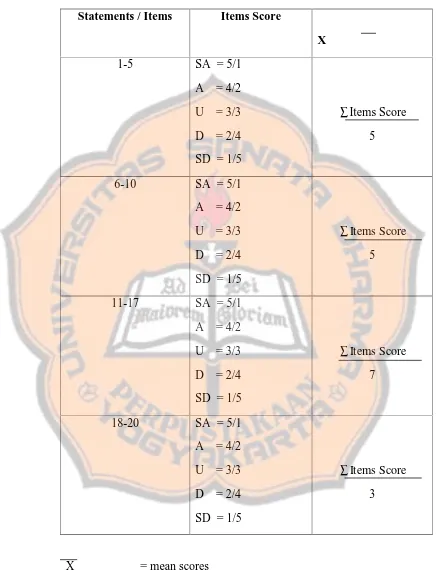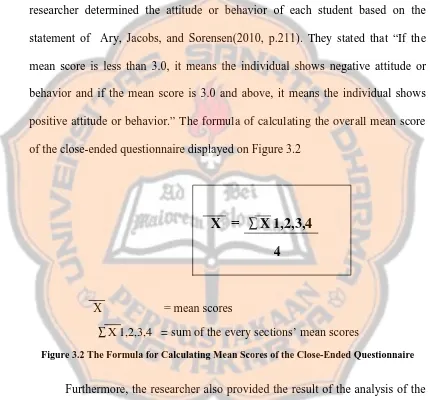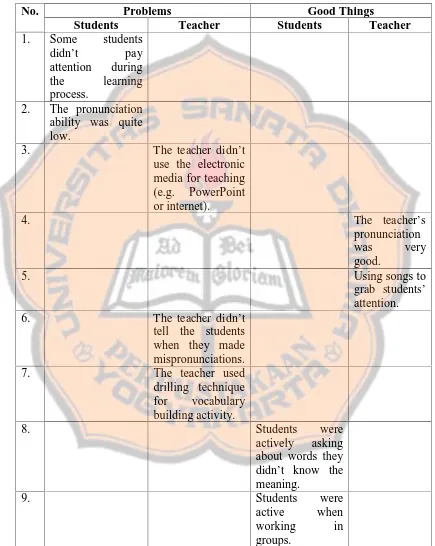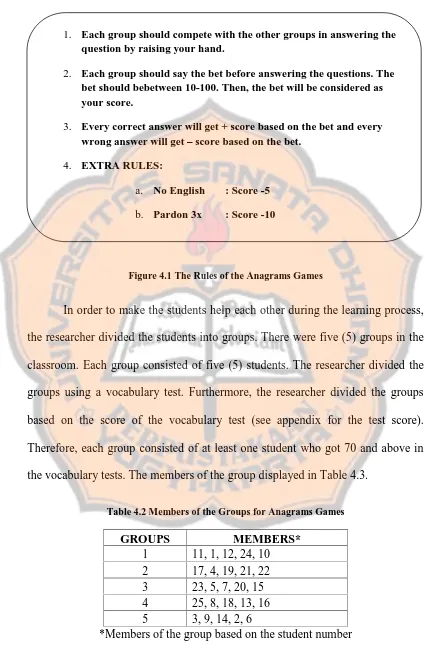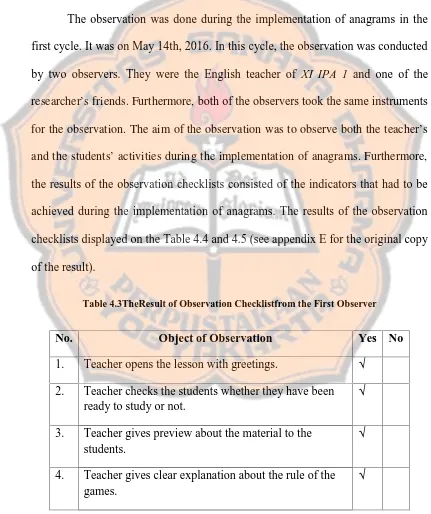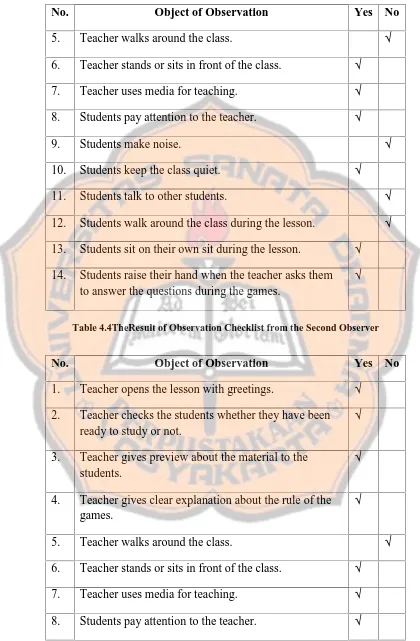ABSTRACT
Kumara, Richard Devara Candra. (2016). The Use of Anagrams to Improve the Students’ Vocabulary Learning Strategy in XI IPA 1 class, SMA Pangudi Luhur Sedayu. Yogyakarta: Sanata Dharma University.
Vocabulary is one of the most important language elements. Thus, the English learners should master vocabulary in order to communicate fluently in English. In order to achieve that, the English learners should apply appropriate learning strategy. After conducting an observation in XI IPA 1 class, SMA Pangudi Luhur Sedayu, the researcher discovered that the students had the difficulties in learning vocabulary, because the students learn vocabulary only with drilling technique.
The purpose of the research was to overcome the problems of learning vocabulary in XI IPA 1 class.Thus, the researcher proposed anagrams as the media for learning vocabulary. The anagrams was in a form of game to give more interesting learning experience to the students. In order to achieve the goal of the research, the researcher formulates the research question as how does the use of anagrams improve the students’ vocabulary learning strategy in XI IPA 1class, SMA Pangudi Luhur Sedayu?
In order to overcome the students’ problem in vocabulary learning strategy, the researcher conducted a Classroom Action Research (CAR) to implement anagrams. This Classroom Action Research consisted of two cycles and there was one meeting on each cycle. Then, each cycle consisted of plan, action, observation, and reflection. The research participants were 25 students of XI IPA 1 class, SMA Pangudi Luhur Sedayu. The researcher used the first three learning stages according to Revised Bloom Taxonomy (2001): remember, undserstand, and apply as the learning goal. The data were gathered by two observers using observation checklists. The researcher also developed close-ended questionnaire in order to discover the opinion of the students related to the implementation of anagrams in vocabulary learning and their future expectation related to vocabulary learning.
Based on the observation, by the end of the study, the students had successfully achieved the learning goal. The students were able to remember the new words, understand the meaning, the spelling, the pronunciation, the synonym, and the part of speech of the words. Then, the students were also able to apply the new words in written form. Furthermore, the students also reacted positively toward the implementation of anagrams for vocabulary learning. The students also expected that the English teacher use anagrams again for vocabulary learning activity. Therefore, it could be concluded that the use of anagrams improved the students’ vocabulary learning strategy. There are also some suggestions for English teachers and future researchers.
ABSTRAK
Kumara, Richard Devara Candra. (2016). The Use of Anagrams to Improve the Students’ Vocabulary Learning Strategy in XI IPA 1 class, SMA Pangudi Luhur Sedayu. Yogyakarta: Sanata Dharma University.
Kosa kata adalah salah satu dari yang paling penting di dalam elemen bahasa. Dalam Bahasa Inggris, vocabulary harus dikuasai oleh siswa/siswi yang belajar Bahasa Inggris agar dapat berkomunikasi dengan lancar. Untuk mencapainya, siswa/siswi harus memiliki strategi belajar yang tepat.Setelah melakukan observasi di kelas XI IPA 1, penulis menemukan bahwa siswa/siswi memiliki kesulitan dalam mempelajari kosa kata, karena siswa/siswi belajar kosa kata menggunakan teknik drilling.
Tujuan dari penelitian ini adalah untuk mengatasi permasalahan dalam belajar kosa kataagar siswa menjadi lebih efektif menggunakan anagrams sebagai media pembelajaran.Untuk mencapai tujuan utama dari penelitian ini, penulis membuat sebuah rumusan masalah yaitu bagaimana penggunaan anagrams meningkatkan strategi belajar siswa/siswi kelas XI IPA 1, SMA Pangudi Luhur Sedayu?
Untuk mengatasi permasalahan siswa/siswi, penulis membuat sebuah Penelitian Tindakan Kelas (PTK) yang mengimplementasikan anagrams.Penelitian Tindakan Kelas ini memiliki dua siklus dan di dalam masing-masing siklus terdapat satu pertemuan.Setiap siklus terdiri dari rencana, tindakan, observasi, dan refleksi.Penelitian ini menyertakan 25 siswa dari kelas XI IPA 1. Penulis menggunakan tiga tahap pertama pembelajaran menurut Taksonomi Bloom yang direvisi (2001): mengingat, memahami, dan menerapkan sebagai tujuan akhir pembelajaran. Data pada penelitian ini dikumpulkan oleh dua orang pengamat menggunakan observation checklists. Penulis juga membuat kuesioner untuk mengidentifikasi pendapat siswa mengenai penerapan anagrams dalam pembelajaran kosa kata dan harapan mereka untuk pembelajaran kosa kata yang akan datang.
Berdasarkan observasi pada akhir penelitian, siswa/siswi telah berhasil mencapai tujuan akhir pembelajaran.Siswa/siswi mampu mengingat kata-kata baru, memahami arti, ejaan, pelafalan, sinonim, dan kategori masing-masing kata-kata baru.Siswa/siswi juga dapat mengaplikasikan kata-kata-kata-kata baru yang mereka dapat secara tertulis.Siswa/siswi juga memberikan reaksi positif terhadap penerapan anagrams dalam pembelajaran kosa kata.Mereka mengaharapkan guru Bahasa Inggris agar dapat menggunakan anagrams lagi dalam pembelajaran kosa kata.Sehingga, dapat disimpulkan bahwa penggunaan anagrams berhasil meningkatkan strategi belajar kosa kata siswa/siswi menjadi lebih efektif. Penulis juga membuat beberapa saran untuk guru-guru Bahasa Inggris dan peneliti yang akan melakukan penelitian dengan topik yang sama.
i
THE USE OF ANAGRAMS TO IMPROVE THE
STUDENTS’ VOCABULARY LEARNING STRATEGY
IN XI IPA 1 CLASS,SMA PANGUDI LUHUR SEDAYU
A SARJANA PENDIDIKAN THESIS
Presented as a Partial Fulfillment of the Requirements
to Obtain the Sarjana Pendidikan Degree
in English Language Education
By
Richard Devara Candra Kumara Student Number: 121214126
ENGLISH LANGUAGE EDUCATION STUDY PROGRAM
DEPARTMENT OF LANGUAGE AND ARTS EDUCATION
FACULTY OF TEACHERS TRAINING AND EDUCATION
SANATA DHARMA UNIVERSITY
YOGYAKARTA
vi
ABSTRACT
Kumara, Richard Devara Candra. (2016). The Use of Anagrams to Improve the Students’ Vocabulary Learning Strategy in XI IPA 1 class, SMA Pangudi Luhur Sedayu. Yogyakarta: Sanata Dharma University.
Vocabulary is one of the most important language elements. Thus, the English learners should master vocabulary in order to communicate fluently in English. In order to achieve that, the English learners should apply appropriate learning strategy. After conducting an observation in XI IPA 1 class, SMA Pangudi Luhur Sedayu, the researcher discovered that the students had the difficulties in learning vocabulary, because the students learn vocabulary only with drilling technique.
The purpose of the research was to overcome the problems of learning vocabulary in XI IPA 1 class.Thus, the researcher proposed anagrams as the media for learning vocabulary. The anagrams was in a form of game to give more interesting learning experience to the students. In order to achieve the goal of the research, the researcher formulates the research question as how does the use of anagrams improve the students’ vocabulary learning strategy in XI IPA 1class, SMA Pangudi Luhur Sedayu?
In order to overcome the students’ problem in vocabulary learning strategy, the researcher conducted a Classroom Action Research (CAR) to implement anagrams. This Classroom Action Research consisted of two cycles and there was one meeting on each cycle. Then, each cycle consisted of plan, action, observation, and reflection. The research participants were 25 students of XI IPA 1 class, SMA Pangudi Luhur Sedayu. The researcher used the first three learning stages according to Revised Bloom Taxonomy (2001): remember, undserstand, and apply as the learning goal. The data were gathered by two observers using observation checklists. The researcher also developed close-ended questionnaire in order to discover the opinion of the students related to the implementation of anagrams in vocabulary learning and their future expectation related to vocabulary learning.
Based on the observation, by the end of the study, the students had successfully achieved the learning goal. The students were able to remember the new words, understand the meaning, the spelling, the pronunciation, the synonym, and the part of speech of the words. Then, the students were also able to apply the new words in written form. Furthermore, the students also reacted positively toward the implementation of anagrams for vocabulary learning. The students also expected that the English teacher use anagrams again for vocabulary learning activity. Therefore, it could be concluded that the use of anagrams improved the students’ vocabulary learning strategy. There are also some suggestions for English teachers and future researchers.
vii
ABSTRAK
Kumara, Richard Devara Candra. (2016). The Use of Anagrams to Improve the Students’ Vocabulary Learning Strategy in XI IPA 1 class, SMA Pangudi Luhur Sedayu. Yogyakarta: Sanata Dharma University.
Kosa kata adalah salah satu dari yang paling penting di dalam elemen bahasa. Dalam Bahasa Inggris, vocabulary harus dikuasai oleh siswa/siswi yang belajar Bahasa Inggris agar dapat berkomunikasi dengan lancar. Untuk mencapainya, siswa/siswi harus memiliki strategi belajar yang tepat.Setelah melakukan observasi di kelas XI IPA 1, penulis menemukan bahwa siswa/siswi memiliki kesulitan dalam mempelajari kosa kata, karena siswa/siswi belajar kosa kata menggunakan teknik drilling.
Tujuan dari penelitian ini adalah untuk mengatasi permasalahan dalam belajar kosa kataagar siswa menjadi lebih efektif menggunakan anagrams sebagai media pembelajaran.Untuk mencapai tujuan utama dari penelitian ini, penulis membuat sebuah rumusan masalah yaitu bagaimana penggunaan anagrams meningkatkan strategi belajar siswa/siswi kelas XI IPA 1, SMA Pangudi Luhur Sedayu?
Untuk mengatasi permasalahan siswa/siswi, penulis membuat sebuah Penelitian Tindakan Kelas (PTK) yang mengimplementasikan anagrams.Penelitian Tindakan Kelas ini memiliki dua siklus dan di dalam masing-masing siklus terdapat satu pertemuan.Setiap siklus terdiri dari rencana, tindakan, observasi, dan refleksi.Penelitian ini menyertakan 25 siswa dari kelas XI IPA 1. Penulis menggunakan tiga tahap pertama pembelajaran menurut Taksonomi Bloom yang direvisi (2001): mengingat, memahami, dan menerapkan sebagai tujuan akhir pembelajaran. Data pada penelitian ini dikumpulkan oleh dua orang pengamat menggunakan observation checklists. Penulis juga membuat kuesioner untuk mengidentifikasi pendapat siswa mengenai penerapan anagrams dalam pembelajaran kosa kata dan harapan mereka untuk pembelajaran kosa kata yang akan datang.
Berdasarkan observasi pada akhir penelitian, siswa/siswi telah berhasil mencapai tujuan akhir pembelajaran.Siswa/siswi mampu mengingat kata-kata baru, memahami arti, ejaan, pelafalan, sinonim, dan kategori masing-masing kata-kata baru.Siswa/siswi juga dapat mengaplikasikan kata-kata-kata-kata baru yang mereka dapat secara tertulis.Siswa/siswi juga memberikan reaksi positif terhadap penerapan anagrams dalam pembelajaran kosa kata.Mereka mengaharapkan guru Bahasa Inggris agar dapat menggunakan anagrams lagi dalam pembelajaran kosa kata.Sehingga, dapat disimpulkan bahwa penggunaan anagrams berhasil meningkatkan strategi belajar kosa kata siswa/siswi menjadi lebih efektif. Penulis juga membuat beberapa saran untuk guru-guru Bahasa Inggris dan peneliti yang akan melakukan penelitian dengan topik yang sama.
viii
ACKNOWLEDGEMENTS
First, I would like to express my gratitude to Jesus Christ for His love,
spirit, guidance, and bless given to me during the process of completing my thesis.
He makes me become a stronger man everyday even when I felt hopeless with my
thesis.
Second, my gratitude goes to my thesis advisor,Drs.Pius Nurwidasa
Prihatin, M.Ed., Ed.D. for giving me time, suggestion, attention, support, and
guiding me patiently to finish my thesis.I also thankLaurentia Sumarni, S.Pd.,
M.Trans.St.for being my academic advisor during my study in English Language
Education Study Program, Sanata Dharma University.
Third, I would like to express my gratitude to Br. Agustinus Mujiya
S.Pd., FIC, the principal of SMA Pangudi Luhur Sedayu, who has permitted me
to do my research in SMA Pangudi Luhur Sedayu. Then, I also thank the English
teacher of XI IPA 1 class, Agnes Erna S., S.Pd.. She always guided me while I
did my research in SMA Pangudi Luhur Sedayu. My gratitude also goes to the
students of XI IPA 1 class for their cooperation in my research.
Fourth, my special thanks are dedicated to my parents, Drs. Aloysius
Candra Widyantara and Dra. Dionysia Sri Kumara Wigati who always give
me their love and support. I also thank my beloved parents who have financed my
study from the beginning of my study in Sanata Dharma. I also express my
ix
Fifth, I also express my special thanks to my girlfriend, Ristri Putri
Utami, who always accompanied me, gave suggestion, and supported me when I
felt hopeless with my thesis. I also want to thank all of my friends from Bengkel
Pulsar Indra99, Indra P., Muhammad Heri, Prabowo Anggara, Fandy
Febiangga, Anggi Putra Siregar, Wisnu Wardhana, and Kang Mul, who
always made me happy when I felt confused and sad. My gratitude also goes to all
of TengkyuBroo guys, Ardhi Caco, Vinsen Hendriya, Adi Setyoko, Gheza
Damara, Patrick Ganang, Patrick Lintang, Kadek Wardana, Aji Prasetyo,
Robertus Septian, Marcell, Pradipta Yunandra, Carolus Praksono, Luther
Jonggi, Veryndra, and Albertus Yordhana, who are my close friends in the
college. I also thank all my friends in PBI Class E 2012 for the experience that is
given to me during my study and for people I know whose names could not be
mentioned one by one.
x
TABLE OF CONTENTS
TITLE PAGE ...i
APPROVAL PAGE ... ii
STATEMENT OF WORK’S ORIGINALITY...iv
PERNYATAAN PERSETUJUAN PUBLIKASI... v
ABSTRACT ...vi
ABSTRAK... vii
ACKNOWLEDGEMENTS ...viii
TABLE OF CONTENTS ... x
LIST OF TABLE ...xiii
LIST OF FIGURES ...xiv
LIST OF APPENDICES ... xv
CHAPTER I. INTRODUCTION ... 1
A. Research Background ... 1
B. Research Problem ... 5
C. Problem Limitation ... 5
D. Research Objective ... 6
E. Research Benefits ... 6
F. Definition of Terms ... 7
CHAPTER II. REVIEW OF RELATED LITERATURE ... 10
A. Theoretical Description ... 10
xi
2. Teaching and Learning Vocabulary ... 11
a. Vocabulary Learning ... 11
b. Vocabulary Learning Strategies ... 12
c. Strategies of Teaching Vocabulary ... 13
3. The Use of Anagrams to Teach Vocabulary ... 13
a. Anagrams ... 13
b. The Benefits of Implementing Anagrams to Teach Vocabulary ... 14
B. Theoretical Framework ... 16
CHAPTER III. RESEARCH METHODOLOGY ... 20
A. Research Method ... 20
B. Research Setting ... 25
C. Research Participants ... 25
D. Research Instruments and Data Gathering Technique ... 26
E. Data Analysis Technique ... 30
F. Research Procedure ... 35
CHAPTER IV. RESEARCH RESULTS AND DISCUSSION ... 39
A. The Implementation of the Classroom Action Research ... 40
1. The Preliminary Study ... 43
2. The Implementation of the First Cycle ... 46
a. Plan ... 46
b. Action ... 46
xii
d. Reflection ... 59
3. The Implementation of the Second Cycle ... 60
a. Plan ... 60
b. Action ... 61
c. Observation ... 68
d. Reflection ... 72
B. The Attitudes of the Students Toward the Implementation of Anagrams ... 74
CHAPTER V. CONCLUSIONS AND RECOMMENDATIONS ... 77
A. Conclusions ... 77
B. Recommendations ... 80
REFERENCES ... 82
xiii
LIST OF TABLES
Table Page
3.1. Table of Instruments and Data Collected ... 30
3.2. The Data Gathered From the Close-Ended Questionnaire ... 32
3.3. The Formula of Calculating Mean Score of the Statements ... 33
4.1. The Problems and Good Things of the Students and the Teacher During the Learning Process ... 39
4.2. Members of the Groups for Anagram Games ... 43
4.3. The Result of Observation Checklist From the First Observer ... 51
4.4. The Result of Observation Checklist From the Second Observer ... 52
4.5. The Result of Observation Checklist From the First Observer... 67
xiv
LIST OF FIGURES
Figure Page
2.1. The Revised Bloom Taxonomy ... 12
3.1. Classroom Actions Research Cycle Developed by Kemmis &
McTaggart (1988) ... 20
3.2. The Formula of Calculating Mean Score of the Close-Ended
Questionnaire ... 34
xv
B. Lesson Plan and Teaching Material ... 90
1. Lesson Plan and Teaching Material First Cycle ... 91
2. Lesson Plan and Teaching Material Second Cycle ... 96
C. Field Note (Preliminary Study) Result ... 102
D. Students’Vocabulary Tests Result and Group Members Distribution ... 104
1. Vocabulary Test ... 105
2. Vocabulary Test Result ... 108
3. Distributions of Group Members ... 110
E. Observation Checklists Result ... 111
1. Observation Checklists Result First Cycle ... 112
a. Observation Checklist Result First Observer ... 112
b. Observation Checklist Result Second Observer ... 113
2. Observation Checklists Result Second Cycle ... 114
a. Observation Checklist Result First Observer ... 114
b. Observation Checklist Result Second Observer ... 115
F. Close-Ended Questionnaire Result ... 116
1. Raw Data of Close-Ended Questionnaire (Diagram) ... 117
CHAPTER I
INTRODUCTION
In this chapter, the researcherdiscusses six major points. They are research
background, research problem, problem limitation, research objectives, research
benefits, and definition of terms. Basically, this chapter contains of the
introduction of this research. The description of each part is discussed below.
A. Research Background
Vocabulary is used in almost all aspects of English (i.e. speaking, writing,
or listening). That is why learning vocabulary is very important for English as a
Foreign Language (EFL) student. In Indonesia, there are a lot of people who want
to be able to master English as their foreign language, but they have problem with
acquiring English vocabulary.The students are expected to master English in four
skills, namely listening, writing, reading, and speaking skill. In order to master
those four skills, firstly the students have to understand deeply on grammar,
pronunciation, and vocabulary.
Vocabulary is important in English learning. “To live in the world, we
have to name every single thing we see. Names are very important. Without name,
it is very hard to accept the existence of an object, an event, or a feeling”(Taylor,
1990, p. 1). In the quotation above, Taylor (1990) considered vocabulary is as
important as a name of person or certain things. That is why vocabulary is
important.
However, many English learners consider that memorizing a lot of English
vocabularies is very difficult although it is the simple one. The result of the
difficulty of learning vocabulary is clear. The students will be lack of vocabulary
knowledge. It will affect the students’ speaking and writing ability. In writing,
when the students are lack of vocabulary, they will still be able to check or open
the dictionary. In speaking the students will tend to stop speaking, saying “eeeee”,
or even say the word in Bahasa Indonesia, when they are lack of vocabulary.
Lack of vocabulary can be a serious problem when the students speak directly
with a foreigner who speaks English or native English speaker.
In addition, the researcher also experienced the problem of mastering
English vocabulary when learning English as a foreign language. Learning
vocabulary in English as a foreign language class was quite hard for the
researcher. Souriyavongsa, Rany, Abidin, Mei (2012) also found problems in
learning English in Laos, where English is also taught as a foreign language in
formal school. Besides, the researcher also shared an experience of teaching
English as a foreign language with a friend, who is an English teacher in one of
formal schools. The researcher found that most problem of mastering vocabulary
is caused by the use of teaching media. The researcher said so because the
researcher was trying to talk with several students. Most of the students said that
to learn vocabulary, the teacher used the drilling technique. They also added that
by using that technique, the students were not interested in learning vocabulary.
Furthermore, the researcher also found the same problem in XI IPA 1
with the English teacher. In order to find the problems in learning vocabulary, the
researcher conducted a directobservation on April 18th, 2016. Based on the
observation, the researcher found the problems related to vocabulary mastery of
the students. During the observation in the class, the researcher found that the students did not understand the teacher’s explanation in English. So, the teacher
had to translate the explanation or instructionto Bahasa Indonesia. Since the
students learned vocabulary through drilling technique, they forget the words that
theylearned.
Thus, the teacher is challenged to create more interesting vocabulary
learning process. The solution that can be applied to solve this problem is
implementing appropriate teaching media. In the High School level,the students
still like to play. Thus, applying games for teaching will be interesting. Harmer
(2002) stated that the games give the learners a feeling of competition to
participate in the process of vocabulary learning and motivate them to learn with
enthusiasm. Besides, games are related to a feeling of happiness. It is in line with
Hadfield (1998), he stated that a game is an activity with rules and elements of
fun. Therefore, students are able to memorize the words effectively. Specifically, the researcher wants to improve the students’ vocabulary learning strategies. The
researcher also tries to help the students to reach the first three stages from
Revised Bloom Taxonomy. Those are remember, understand, and apply.
Therefore, the students are hoped to remember the words, understand the words,
Furthermore, the media which was applied in this research is word games.
The example of word games are puns, riddles, crossword puzzles, anagrams, and
palindromes (Dale & O'Rourke, 1971). The researcher chooses anagrams as a
learning media to teach vocabulary to XI IPA 1 students.According to Dale & O’Rourke (1971), anagrams are words made by transposing letters of one word to
form another. To make the students face less difficulty when answering the
question, there are clues in anagrams.
The researcher’s choice is also supported by Dale & O'Rourke(1971).
They summarized that“students are able to enjoy games and exercises when using
puns, riddles, crossword puzzles, anagrams, and palindromes” (Dale & O’Rourke,
1971, p.302). Further, by using anagrams the students are also given a chance to
learn how to spell every word correctly. Dale & O'Rourke (1971) also stated that
anagrams will make the students are able to emphasize on the importance of letter
position in relation to word meaning. In addition, anagrams are used to develop an
interest in every word. Therefore, the students are curious to dig more information
about the word and it is likely to improve their vocabulary.
In order to solve the students’ problems in learning vocabulary, the
researcher proposes anagrams as the media to teach vocabulary. The researcher
thinks that anagrams is one of the media that can be used to teach vocabulary
effectively. Therefore, the researcher applies Classroom Action Research to
B. Research Problem
Based on the research background, the researcher formulates the research
problem by using this research question: how does the use of anagram improve the students’ vocabulary learning strategy in XI IPA 1class, SMA Pangudi Luhur
Sedayu?
C. Problem Limitation
This research focuses on the implementation of anagrams to improve the students’ vocabulary learning strategy in XI IPA 1 class, SMA Pangudi Luhur
Sedayu. This study also focuses on spelling ability and the ability to recognize the
meaning of every word. Furthermore, the researcher also uses the first three stages
of learning according to Revised Bloom Taxonomy as the vocabulary learning
goal. Meanwhile, anagrams is the media which is used to help the students
discover new vocabulary. The researcher uses the instructions which are proposed
by Dale and O'Rourke(1971) to construct the anagrams as the media to teach
vocabulary.
This research was conducted in SMA Pangudi Luhur Sedayu and involved
25 students of XI IPA 1 class, SMA Pangudi Luhur Sedayu. The researcher chose
this class because in this class the researcher found the problems of vocabulary
learning through the discussion with the English teacher and the observation
D. Research Objectives
The objective of this research is to implement anagrams to improve the students’ vocabulary learning strategy in XI IPA 1 class, SMA Pangudi Luhur
Sedayu.
E. Research Benefits
The researcher expected that this research gives benefits for:
1. The Students of XI IPA 1class, SMA Pangudi Luhur Sedayu
The researcher hopes that this research gives positive contributions to the
students of XI IPA 1 class,SMA Pangudi Luhur Sedayu. This research is expected
to help the students learn vocabulary easily, effectively, and happily using
anagrams. This media is also expected to be more motivating for the students to
learn vocabulary. As the result, the students are able to understand the correct
meaning and spelling of every word they learn.
2. The English Teacher of SMA Pangudi Luhur Sedayu
The researcher provides some information and instructions about how to
construct anagrams for vocabulary learning. Using anagrams can be one of the
best solutions to be implemented in vocabulary learning. Therefore, the English
teacher can use anagrams as a media to introduce new words in vocabulary
learning. It is also hoped that the teacher is able to elaborate more the media and
3. Future Researchers
The researcher also hopes that this research can inspire other researchers
who are also interested in this topic. Hopefully, this research can stimulate other
researchers to develop more and conduct further research related to this topic. It is
also hoped that future researchers are able to develop more about the use of
anagrams to teach vocabulary.
F. Definition of Terms
The researcher provides the definition of terms that related to this study.
They are vocabulary learning, anagrams, and the students of XI IPA 1 SMA
Pangudi Luhur Sedayu. Those are described as follows.
1. Vocabulary Learning
According to Wallace (1982), vocabulary learning is a complex process
which requires the ability to recognize the words, remember them, and to
pronounce, spell and use them correctly. It means that the main goal of
vocabulary learning is to make the studentsable to recognize the words, remember
them, and also pronounce and spell the words correctly. In addition Allen and
Vallete (1972) stated that vocabulary learning can be meaningful if the teacher
can conduct the teaching process by combining the available techniques of
teaching. In this study, the vocabulary learning refers to the activity of the
2. Vocabulary Learning Strategy
According to Catalan (2003), vocabulary learning strategy is a process or strategy
which provides certain steps taken by learners to learn vocabulary. In this study, the
researcher sets 3 steps for the vocabulary learning strategy. The steps are the first three
steps of Revised Bloom Taxonomy. They are remember, understand, and apply. Thus, the
students are expected to remember the new words, understand them, and apply them. The
researcher only takes the first three steps of the Revised Bloom Taxonomy because of the
limited time.
3. Anagrams
According to Dale & O'Rourke (1971) anagrams are words made by
transposing letters of one word to form another. In addition, Dale & O’Rourke
(1971) stated that anagrams comes from Greek ana (back) + gramma (letter). In
this study, anagrams are the media which are used to help the students of XI IPA
1, SMA Pangudi Luhur Sedayu to learn vocabulary.
The researcher prepared the anagrams. The wordsin the anagrams are
based on the reading passage which is related to the material. In this research, the
anagrams have a clue and some have two clues to help the students answer the
questions. The clues are in the form of the definition of the words, the synonim, or the part of speech, for example “Key word: LAME, Clue: Synonim of food,
4. The Students of XI IPA 1 class, SMA Pangudi Luhur Sedayu
The participants of this study are the students of XI IPA 1. The XI IPA 1 is
one of the classes in SMA Pangudi Luhur Sedayu in the academic year 2015/2016.
There are twenty five students in this class. They consist of seventeen female
CHAPTER II
REVIEW OF RELATED LITERATURE
In this chapter, the researcher presents a discussion on the related literature
review. It also presents two main parts, theoretical description and theoretical
framework. Theoretical description contains the theories which are related to the
research. The theories in theoretical description are used as the basic to form
theoretical framework of this research. The theoretical framework discusses the
major theories that are relevant to help the researcher implementsanagrams to
teach vocabulary.
A. Theoretical Description
This part presents the appropriate theories which are implemented in this
research. The aim is to give a basic understanding of theories that are used to
conduct this study. The researcher divides this part into three sections. The first
section is vocabulary knowledge and vocabulary mastery. The second section
discusses teaching and learning vocabulary. The third section discusses about the
use of anagram to teach vocabulary.
1. Vocabulary Mastery
Vocabulary Mastery is an ability to understand and to know words and
implement the words in communicating with others. Nunan (2003) states that
students who have vocabulary mastery are the students who know multi word
units, word families, and core meanings. Thus, when English learners know about
multi words, what the meaning is, how to pronounce, and where should be
implemented. They can be considered that they have good vocabulary knowledge
or they have vocabulary mastery.
However, knowing and understanding vocabulary are not just the matter of
remembering or memorizing the words. As cited in Thornburry (2002, p.15), “in
the most basic level, a student is considered that they are already knowing a word
when he/she knows its form and its meaning.”Furthermore, Schmitt (2000) added
that learning words entails more than knowing its spelling, meaning, and
pronunciation. In this study, the researcher emphasizes vocabulary mastery which refers to the students’ understanding of each word and the ability to spell and to
pronounce each word correctly.
2. Teaching and Learning Vocabulary
The researcher divides this section into three parts. They are vocabulary
learning, vocabulary learning strategies, and strategies of teaching vocabulary.
a. Vocabulary Learning
Vocabulary is very important in language learning. “To live in the world,
we have to name every single thing we see. Names are very important. Without
name, it is very hard to accept the existence of an object, an event, or a feeling
(Taylor, 1990, p. 1).”In the quotation above, Taylor (1990) stated that vocabulary
is as important as a name of person or certain thngs. That is why vocabulary is
important. Besides, by acquiring more vocabulary, the students can develop their
When the students learn vocabulary, the students should be able to
understand the meaning of the words and the uses of the words in context.
Besides, the students are also expected to be able to spell and pronounce the
words correctly. It is in line with the statement by Wallace (1982), he summarized that “vocabulary learning is a complex process which requires the ability to
recognize the words, remember them, and to pronounce, spell and use them correctly.” Thus, it can be concluded that learning vocabulary is difficult. It is
because there are some aspects that students need to acquire. In addition, Nation
(1990) adds that there are three aspects in knowing word, (1) knowing its form,
(2) knowing its meaning, and (3) knowing its use. Therefore, in learning
vocabulary, the students have to know the spelling of the word, the meaning of the
word, and the function of the word or the use of word. Furthermore, the researcher
also applied the first three stages of learning according to Revised Bloom
Taxonomy as the vocabulary learning goal in this study. Those three stages are
remember, understand, and apply. Therefore, by the end of the implementation of
anagrams, the researcher expected the students to remember new words,
Figure 2.1 The Revised Bloom Taxonomy (Anderson & Krathwohl, 2001)
In order to drive the learning process into the successful one, the teachers
have to be more creative in creating teaching strategies. It means that the teacher
who is be able to create meaningful vocabulary learning. He or she will lead
his/her students to be successful in learning vocabulary. Allen and Vallete (1972)
state that vocabulary learning can be meaningful if the teacher can conduct the
teaching process by combining the available techniques of teaching.
b. Vocabulary Learning Strategies
The teacher has to pay attention to vocabulary learning strategies when
constructing vocabulary learning. Generally, the strategies are making the plan
and doing the plan to construct meaningful vocabulary learning. Catalan (2003)
states that vocabulary learning strategy is a process or strategy which provides
1) To define the meaning of unknown words.
2) To retain them in long-term memory.
3) To recall them at will.
4) To use them in oral or written mode.
c. Strategies of Teaching Vocabulary
Teaching vocabulary for English as a Foreign Language student is quite
challenging. According to Catalan (2003), as vocabulary learners, the students
have to be able to:
1) To define the meaning of unknown words.
2) To retain them in long-term memory.
3) To recall them at will.
4) To use them in oral or written mode.
In order to facilitate the students, the teachers have to design good learning
materials. According to McCarten (2007), materials can help students in two
broad areas. The need to present and practice in natural contexts the vocabulary
that is frequent, current, and appropriate to learners’ needs. Then,materials should
help students become better learners of vocabulary by teaching different
3. The Use of Anagram to Teach Vocabulary
a. Anagrams
In teaching vocabulary, teachers have to be more creative in designing the
learning materials. To be more creative means teachers are able to design
interesting materials that can make the learning process more fun and enjoyable
for students. Dale & O’Rourke (1971) state that an important objective of
vocabulary instruction is to develop an interest in words. One of the interesting
materials for learning vocabulary is using word games exercises. According to Dale & O’Rourke (1971), there are several types of word games, they are puns,
riddles, crossword puzzles, anagrams, and palindromes. In this research, the
researcher particularly chose only one type of word games. It is anagrams.
According to Dale & O’Rourke (1971), anagrams is words made by
transposing letters of one word to form another. There is a clue in anagrams.
Sometimes, there are two clues. The clues show the meaning or the synonym of
the word. The clues are given to help the students answer the question easier.
b. The Benefits of Implementing Anagrams to Teach Vocabulary.
By implementing anagrams, the teacher can help the students to increase
their self-confidence. It is because the students feel more confident when they
answer the word correctly. In addition, Harmer (2002) states that the games give
the learners a feeling of competition to participate in the process of vocabulary
learning and motivate them to learn with enthusiasm. In relation with the use of
the students. There are two positive effects when the teachers implement
anagramsas teaching media to teach vocabulary.
1. The Students are Aware of the Difference between Words
In English, there are some words that are close enough. It means that some
words have the same spelling, same pronunciation, or even same stressed syllable
but they share different meaning. Some English learners are facing the same
difficulty to differ words in the same spelling, the same pronunciation, or the
same stressed syllable with different meaning. By using anagrams as teaching
media to teach vocabulary, the students have the opportunity to understand each word carefully. The researcher’s statement is in line with the statement of Dale
and O’Rourke (1971). “Word games will require the students to look carefully at
each word. This is an important aspect of vocabulary building (Dale & O'Rourke,
1971, p. 302).” When the students have the opportunity to look carefully on each
word, the students will be able also to see the difference between words with the
same spelling, pronunciation, and stressed syllable. In anagrams, there are clues
provided. Those clues make the students understand the correct word. Although
the jumbled letter can be formed into another word, the clues give the information
about the correct word. It also gives the students the opportunity to understand
that the letters can be manipulated to form new word. This is supported by Dale & O’Rourke (1971), showing the students how the letters of many words can be
2. The Students Understand Deeply about The Words and Their Meaning
In order to master vocabulary, English learners should understand deeply
the words. It means that the students are able to classify the words based on the
context and the meaning. In order to be able to understand the words in context,
the students should be able to at least generalize the concepts of words. By using
anagrams as the teaching media to teach vocabulary, anagrams encourage the
students to classify and generalize concepts. Dale & O’Rourke (1971)
summarized that word games encourage the students to classify and generalize
concepts (Dale & O'Rourke, 1971).
B. Theoretical Framework
This research focuses on the use of anagrams to help the students of XI
IPA 1 class, SMA Pangudi Luhur Sedayu in learning vocabulary. Thus, in this
research, the researcher used three main theories. They were vocabulary learning,
strategies of teaching vocabulary, and anagrams.
The vocabulary learning is an activity of learning which is the main focus
in this research. The researcher uses the theory developed by Nation (1990) about
three aspects in knowing word, they are (1) knowing its form, (2) knowing its
meaning, and (3) knowing its use. In this study, the researcher particularly focuses
on those three aspects. Knowing the form is to know the spelling of the word.
Knowing the meaning is to know whatthe meanings of the word, because for
some words they have more than one meanings. Knowing the use is to know
when or where the word should be used including its synonim. Besides, the
vocabulary learning goal. The researcher expected the students to remember new
words, understand them, then apply them by the end of the implementation of
anagrams.
Furthermore, a succesful vocabulary learning needs a good technique
which is developed by the teacher. Allen and Vallete (1972) stated that
vocabulary learning can be meaningful if the teacher can conduct the teaching
process by combining the available techniques of teaching. In line with the
statement of Allen and Vallete (1972), the researcher developed games as a
technique to teach vocabulary.
In this research, the researcher proposed anagrams as a media to teach
vocabulary and to help the students of XI IPA 1 in learning vocabulary. According
to Dale and O’Rourke (1971), anagrams arewords made by transposing letters of
one word to form another. The researcher also provided clues to make the
students easier in answering the question in anagrams. The clues were in a form of
short sentences. The researcher constructed anagrams based on the examples and
instructions developed by Dale & O’Rourke (1971). In addition, the researcher
also constructs the anagrams based on the material that the students learn at the
moment.
The researcher conducts a Classroom Action Research (CAR) to solve the
problem faced by the students of XI IPA 1 class, SMA Pangudi Luhur Sedayu in
learning vocabulary. In this study, the researcher uses the Classroom Action
this model, the Classroom Action Research consists of two cycles.In each cycle,
there are four main activities, they are plan, action, observation, and reflection.
CHAPTER III
RESEARCH METHODOLOGY
This chapter talks about the methodology in this research. Then, the
researcher divides this chapter into six parts of discussion. Those are the research
method, the research setting, the research participants, the research instruments
and data gathering technique, the data analysis, and the research procedure.
A. Research Method
The researcher used Classroom Action Research (CAR) as the
methodology for the research. The aim of this Classroom Action Research was to
help the students of XI IPA 1 class, SMA Pangudi Luhur Sedayu in learning
vocabulary by using anagrams. The researcher conducted this Classroom Action
Research because the researcher found some problems in the vocabulary learning
during the preliminary study. Further, the researcher wanted to solve the problems
and help the students to learn vocabulary effectively.
Basically, the Classroom Action Research is a research which is conducted
to improve certain condition or solve certain problem in the educational field. In
this research, the Classroom Action research was conducted to overcome the
problem in learning vocabulary. According to Fraenkel and Wallen (2009), action
research is a research conducted by one or more individuals or groups for the
purposes of solving a problem or obtaining information in order to inform local
practice.Therefore, in educational field, Classroom Action Research has a
function to solve problems which occurs in the classroom during teaching and
learning process.
Furthermore, in this study, the researcher conducted the Classroom Action
Research in order to solve the problems which werefound during the preliminary
study. After observing and analyzing the students’ problems, the researcher
planned an action (teaching and learning process) together with the English
teacher of XI IPA 1. Then, the researcher implemented the treatmento solve the
problems in learning vocabulary.
In this research, the researcher used the Classroom Action Research model
which was proposed by Kemmis and McTaggart (1988). There are two cycles to
implement the action. The researcher also implemented two cycles in this
research. The first cycle consisted of plan, action, observation, and reflection.
Further, the second cycle consisted of the improvement of the first cycle.
However, the steps are still the same. There were plan, action, observation, and
reflection, but the plan was revised and improved based on the mistakes that
occured in the first cycle. Based on Kemmis and McTaggart’s model of
Classroom Action Research, this research combined the two steps, action and
observation into one stage. It means when the action was implemented in the
teaching and learning process, the researcher also did the observation directly in
the classroom. Further, the researcher used the spiral model proposed by Kemmis
Figure 3.1 Classroom Ac
m Action Research Cycle developed by Kemmis & M
udy
researcher implemented the plan of Cla
rcher conducted a preliminary study. Mills (2011
is a process of gathering information in order l idea in conducting the research. The researc
during the teaching and learning process in the
ion, the researcher used field notes to identify the
vocabulary learning process in the classroom.
cycle, the researcher implemented four steps. T
on, reflection and those described as follows.
a. Plan
In this stage, the researcher discussed the plan with the English teacher of
XI IPA 1. It was for deciding the material and the action to overcome the problems
which discovered during the preliminary study. The researcher designed the
material and the media based on the material in their syllabus. The material was
Hortatory Exposition. Besides, in implementing anagrams, the researcher also
prepared a lesson plan which was made based on School Based Curriculum. The
researcher applied the lesson planfor one meeting on May 14th, 2016.
The researcher also designed two instruments to collect the data during the
learning process. They were observation checklist and field notes. Those two
instruments were used to check and identify the students reaction or behavior
towards the learning process. In addition, the main focus of this stage was to
prepare a good media to help the students of XI IPA 1 in learning vocabulary.
b. Action
In this second stage, the researcher implemented anagrams on May 14th,
2016. The researcher implemented the materials and media which were prepared
in the previous stage. The main focus of this stage was to implement anagrams for
vocabulary learning. Besides, the researcher also conducted some activities related
to the material which was discussed in the learning process. It was also used to
trigger the imagination and also motivation of the students to play anagrams. The
more specific explanation of the implementation of anagrams would be
c. Observation
During the implementation of anagrams, the researcher asked the English
teacher to help the researcher to observe the learning process. Besides, the researcher also asked one of the researcher’s friends to observe the learning
process. Further, the researcher also recorded the learning process to help the
researcher analyze the implementation deeper. The observers used two kinds of
research instruments. Theywere observation checklists and field notes. The
observation checklists consisted of 14 object of observation which was referring
to the activities of the teachers and the students during the learning process. Then,
the field notes were in the form of blank notes. However, the researcher designed
the field notes to be filled every 10 minutes. Therefore, the observers had to fill
the field notes every 10 minutes with significant activities related to the learning
process. Further, the researcher used those two instruments to make a reflection
from the first cycle.
d. Reflection
In this stage, the researcher reflected the implementation of the first cycle.
The purpose was to identify what worked well and what needed some
improvements. Furthermore, the researcher also wanted to find out whether or not
the first action was successful. The researcher used the result of the reflection to
prepare the second cycle. The researcher constructed the reflection of the first
cyclebased on the data from the observation checklists, field notes, and also the
The researcher focused on the implementation of anagrams and the students’ behavior towards the implementation of anagrams. In making anagrams,
the researcher tried to follow the instructions which developed by Dale and
O'Rourke(1971). Therefore, the researcher focused on what had been good from
the anagrams and what needed to be improved. Besides, the researcher also
focused on the students’ behavior towards the implementation of anagrams. The
purpose was to see whether the students enjoy playing anagrams or not. Besides,
the purpose was also to see the participation of each student during the game.
3. Second Cycle
The researcher used the same steps with the first cycle. The researcher
conducted the second cycle as the improvement of the first cycle based on the
reflection of the first cycle. The steps were the same with the first cycle. They
were plan, action, observation, reflection and described as follows.
a. Plan
The researcher revised the plan which was considered unsuccessful in the
first cycle. The learning material was still the same, which was Hortatory
Exposition. The researcher just continued the material which was discussed in the
previous cycle. However, the researcher still had to revised some learning material
which was thought to be unsuccessful. In the second cycle, the researcher revised
the rule of the games and raised the difficulty level of the anagrams. In addition,
the researcher also made new lesson plan for one meeting in the second cycle and
prepared the observation instruments for the second cycle (i.e.observation
b. Action
In this stage, the researcher implemented the revised plan which was
developed based on the reflection of the first cycle. The researcher implemented
the plan on May 21st, 2016. The purpose of implementing the revised plan was to
improve the learning actvity which was not working well in the first cycle. In the
second cycle, the researcher was still a teacher and the English teacher helped the
researcher to observe the learning activity. Besides, the researcher also asked one of the researcher’s friends to help the researcher to observe the learning activity.
The researcher still implemented the same media which was implemented
in the first cycle to teach vocabulary. However, the researcher revised some rules
in the games to improve the implementation of anagrams in the second cycle.
Furthermore, the researcher also added some activities beside the game to make
the students more active in the learning process.
c. Observation
During the implementation of the revised plan in the second cycle, the
researcher also observed whether the plan worked well or not. The observation
was done by two observers, the English teacher of XI IPA 1 and one of the researcher’s friends. The instruments which were used in the second cycle were
the same as the first cycle. They are observation checklists and field notes.
Further, the researcher added one instrument to collect the data from the
students.It was close ended questionnaire. The researcher used the questionnaire
to gain the information about what the students experienced, what the students felt
d. Reflection
As the researcher did in the cycle one, the researcher also reflected the
implementation of anagrams in the second cycle. The researcher developed the
reflection based on the data which was collected in the second cycle. The
researcher also reflected what worked well, what needed to be improved, and
whatthe improvementmade by the students was. As the results, the students were
more active during the learning activity and the students found the more effective
strategy in learning vocabulary.
B. Research Setting
The research took place in SMA Pangudi Luhur Sedayu which is located at
Jl. Wates Km.12 Argosari, Sedayu, Bantul. This school established in early 1968
with the name SPG (Sekolah Pendidikan Guru) Pangudi Luhur Sedayu. Then, this
school oficially changed from SPG (Sekolah Pendidikan Guru) into SMA (Sekolah
Menengah Atas) in 1989. This school has approximately 350 students and the
students come from many different regions across Indonesia.
There were twelve classes in SMA Pangudi Luhur Sedayu. There were
four classes in the tenth grade (XA, XB, XC, and XD), four classes in the eleventh
grade (XI IPS 1, XI IPS 2, XI IPA 1, and XI IPA 2), and four classes in the twelfth
grade (XII IPS 1, XII IPS 2, XII IPA 1, and XII IPA 2). In every class, there were
approximately 25-32 students. Specifically, the researcher conducted this research
C. Research Participants
The research participants were the students of XI IPA 1 class in SMA
Pangudi Luhur Sedayu in the academic year 2015/2016. There were four classes
for the eleventh grades in the school. There were two classes in social department,
XI IPS 1 and XI IPS 2. Then, there were two classes in science department, XI IPA
1 and XI IPA 2. The researcher chose the students of XI IPA 1as the research
participants because based on the discussion between the researcher and the
English teacher that XI IPA 1 students faced problems in learning vocabulary.
There were twenty five students in this classroom which consisted of eight male
students and seventeen female students.
D. Research Instruments and Data Gathering Technique
This section described the research instruments and the data gathering
techniqueused in this research. Then, the researcher divided this section into three
parts. The first part described the research instruments and the data gathering
technique in the preliminary study. The second part described the research
instruments and the data gathering technique in the implementation of Classroom
Action Research. The last part consisted of the instrument that used after the
implementation of Classroom Action Research.
1. Before the Implementation of Classroom Action Research
Before implementing Classroom Action Research, the researcher
conducted a preliminary study. In the preliminary study, the researcher only used
one research instrument to gather the data. That was field notes. The researcher
note focused on the educational setting. According to Ary et al. (2010, p.431), “field note is the most common instrument which is used to record the data during
the observation.”The researcher choice to use field notes also supported by Best
& Kahn (2006). They summarized that “Observation often called fieldwork, because it takes place in the field. The researcher must take field notes.” (Best &
Kahn, 2006, p.265). The use of field note in this research was to help the
researcher identify the problems in the learning process.
Therefore, during the observation, the researcher focused on the students’
activities, the learning process, the teaching technique, and the learning strategies
in the classroom. Specifically, the researcher also focused on how the teacher
developed an activity for vocabulary learning. This instrument was used by the
researcher to identify the problems which occured in XI IPA 1 on April 18th, 2016.
2. During the Implementation of Classroom Action Research
During the implementation of Classroom Action Research, the researcher
also used one research instrument. That was observation checklists. The
researcher used the observation checklist to gather the data during the
implementation of anagrams. Burns (1999, p.80) summarized that “the
observation was very essential in doing a Classroom Action Research.” In addition, Burns (2010, p.62) added that “the observation checklist is usually
implemented in a systematic or structured observation.” The researcher used
observation checklist to check whether the aspects that have to be fulfilled during
the implementation were fulfilled or not. Therefore, the researcher used the data
the researcher used the data from the second observation checklist to identify if
there was any improvement in the second cycle. Further, the researcher also used
both observation checkliststo make the reflection about the overall activity.
The observation checklist in the first and second cycle were different. It
was because in the second cycle, there were some objects of observation added to
improve the analysis of the second cycle. There were 14 objects of observation in the first cycle’s observation checklists and 18 objects of observation in the second
cycle’s observation checklists. In addition, the researcher also used field notes.
The researcher used field notes to take notes of the important things during the
implementation. Furthermore, the researcher used the notes for the discussion
with the observers after the implementation. Besides, the notes also helped the
researcher to record some activities during the implementation. Thus, the
researcher did not miss the important activities during the implementation of
anagrams.
3. After the Implementation of Classroom Action Research
After the implementation of Classroom Action Research, the researcher
wanted to know deeper about the students’ experience, opinion, feeling towards
the implementation of anagrams for learning vocabulary. Further, the researcher
also wanted to know what they actually expect for future vocabulary learning. In
order to gather the data, the researcher used close-ended questionnaire. The
expectation of future vocabulary of the students also gathered through this
instrument. Ary, Jacobs, and Sorensen (2010, p.392) summarized that “The
they also added that a closed format also ensures that all subjects have the same
frame of reference in responding and may also make it easier for subjects to
respond to questions on sensitive or private topics.
Furthermore, the researcher developed the close-ended questionnaire with
Likert Scale type. Likert(1932) as cited in Ary, Jacobs, and Razavieh (1990,
p.234) stated that the Likert Scale has been one of the most widely and
successfully used techniques to measure attitudes. Ary, Jacobs, & Razavieh
(1990) also explained that a Likert scale assesses attitudes toward a topic by
asking respondents to indicate whetherthey strongly agree, agree, are undecided,
disagree, or strongly disagree with each of a series of statements about the topic.
In this close-ended questionnaire, there were twenty statements whichwere
followed by five opinions of Strongly Disagree (SD), Disagree (D), Undecided
(U), Agree (A), Strongly Agree (SA). In addition, the researcher distributed the
close-ended questionnairesto the students of XI IPA 1 on May 26th, 2016 several
days after the implementation of the second cycle. The name of the students were
not required when filling the questionnaire. Diem(2002, p.3) summarized that “When names are not required in questionnaire, the researcher is able to collect
Table 3.1 Tables of Instruments and Data Collected
In this research, the researcher used both qualitative and quantitative
approaches. The qualitative instrument was referring to the result of the
observation checklists. Furthermore, the quantitative instrument was referring
tothe close-ended questionnaire.
The observation checklists were used in order to gather the qualitative data
during the implementation of anagrams in Cycle 1 and Cycle 2. The researcher
analyzed the observation checklistsin order to check what aspects went well and
what aspects went wrong. Thus, the researcher analyzed the students’ and the teacher’s activities during the implementation of anagrams based on the
After implementing anagrams, the researcher wanted to gather some data
from the students of XI IPA 1. The researcher expected the data of the point of
view of the students towards the implementation of anagrams, the experience that
they got during the implementation of anagrams, their opinions towards the use of
anagrams for learning vocabulary, and the expectation for future vocabulary
learning. In order to gather those data, the researcher chose close-ended
questionnaire as the instrument. In the questionnaire, the researcher chose Likert
Scaleas the measuring scale. The researcher analyzed the close-ended
questionnaire by using Scoring Likert Scale method as cited in Ary, Jacobs, and
Sorensen(2010, p.210-211).
According to Ary, Jacobs, and Sorensen (2010, p.210), “Every positive
statements, Strongly Agree is scored 5, Agree is scored 4, Undecided is scored 3,
Disagree is scored 2, and Strongly Disagree is scored 1. For negative statements,
Strongly Agree is scored 1, Agree is scored 2, Undecided is scored 3, Disagree is scored 4, and Strongly Disagree is scored 5.” Furthermore, the researcherdivided
the close-ended questionnaire into 4 sections to gather the data. The first section
was statement 1-5 to gather the general point of view of the students towards
English lesson. The second section was statement 6-10 to gather the experience of
the students in learning vocabulary before the implementation of anagrams. The
third section was statement 11-17 to gather the experience of the students during
the implementation of anagrams. Besides, the third section was also used by the
anagrams. Lastly, the fourth section was statement 18-20 to gather the expectation
of the students for future vocabulary learning.
Table 3.2 The Data Gathered from the Close-Ended Questionnaire
Statements
Data Gathered
1-5 General point of view of the students towards English lesson.
6-10 The experience of the students in learning vocabulary before the implementation of anagrams.
11-17 The experience of the students during the implementation of anagrams and the opinion of the students towards the implementation of anagrams.
18-20 The expectation of the students for future vocabulary learning.
The researcher counted the mean score of each section of statements to
determine the attitude or behavior of the students. According to Ary, Jacobs, and
Sorensen(2010, p.211), “If the mean score is less than 3.0, it means the individual
shows negative attitude or behaviour and if the mean score is 3.0 and above, it
means the individual shows positive attitude or behaviour.” The formula of
After calculating the mean scores of each section of statements, the
researcher also counted the mean scores of overall statements in the close-ended
questionnaire. It was used in order to determine whether the students had positive
or negative attitude/behavior towards the implementation of anagrams. The
researcher determined the attitude or behavior of each student based on the
statement of Ary, Jacobs, and Sorensen(2010, p.211). They stated that “If the
mean score is less than 3.0, it means the individual shows negative attitude or
behavior and if the mean score is 3.0 and above, it means the individual shows
positive attitude or behavior.” The formula of calculating the overall mean score
of the close-ended questionnaire displayed on Figure 3.2
X = mean scores
∑ X 1,2,3,4 = sum of the every sections’mean scores
Figure 3.2 The Formula for Calculating Mean Scores of the Close-Ended Questionnaire
Furthermore, the researcher also provided the result of the analysis of the
close-ended questionnaire in adiagram. It was used to support the improvement
which had been achieved by the students of XI IPA 1 after the implementation of
anagrams in Cycle 2. The positive response and attitude towards the
implementation of anagrams could be seen through the result of the close-ended
questionnaire.
